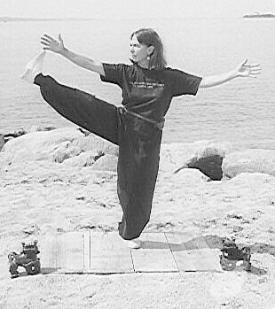About Tai Ji Quan
by Diane Hoxmeier (last paragraph by Master Henry Look)
Tai Ji Quan, often known in America as TAI CHI, is a set of 64 movements, none done slower or faster than the others, developed by ancient Chinese sages who watched the movements of birds and animals. Primarily, Tai Ji is an exercise for health; practiced slowly, it increases strength, balance and coordination; practiced with total body relaxation and no force, it promotes better circulation and calms the mind. Secondarily, the circular movements and postures of Tai Ji Quan, which can be roughly translated as "supreme ultimate boxing", if practiced correctly for several years, could be used for self-defense.
How old is Tai Ji? The form is based on the ideas from Daoism, a philosophy or world view derived from the I Ching (Book of Changes) and from the writings of Lao Tzu. The I Ching, which embodies the idea of yin and yang and their opposition, alternation and interaction, originated and developed in the 2nd and 3rd centuries, B.C.E. Lao Tzu wrote the book, the Dao De Ching, sometime during the 5th century, B.C.E. A common image in this book is water, which is soft and yielding but can overcome the hardest of substances. So, too, is Tai Ji Quan, seemingly soft and yielding but with the capacity for great power.
Tai Ji Quan is a beautiful physical exercise handed down for centuries that one can practice today, indoors or outside, at home or away, with fellow Tai Ji players or alone. No equipment necessary. Anyone of any age, male or female, in almost any physical condition, can begin to learn Tai Ji to prolong life.
Guang Ping Yang Tai Ji Quan is a blend of Yang and Chen schools of Tai Ji. It's stances are lower than Yang but not so low as Chen. It is a combination of hard and soft style and uses both big and small circles. There is a double jump kick, and other wide sweeping kicks; the movements are longer and deeper, more energetic, with more apparent martial combat character.


